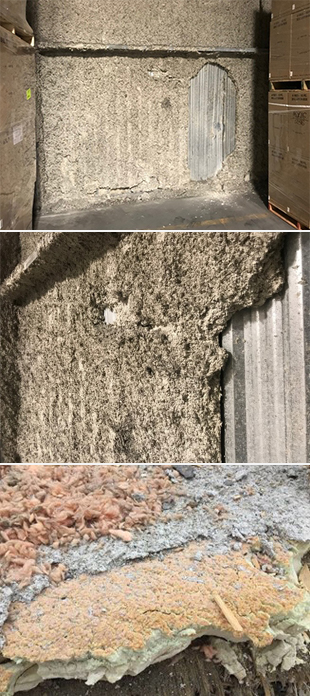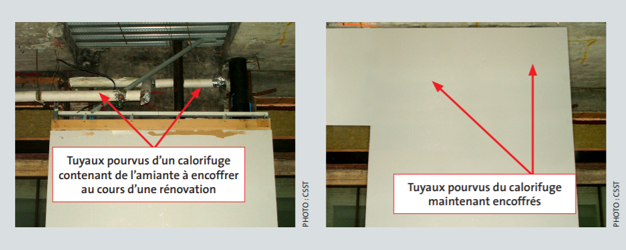Cost and turnaround time
Register
- Building inspection to locate flocking or heat insulating material (lagging) and preparation of the register
- Starting at $750
- Register available within 4 to 6 business days following the inspection
What is it exactly?
Since June 2013, employers and owners of buildings used by workers are required to have inspections done to check whether they contain flocking (if built before February 15, 1990) or heat insulating material (if built before May 15, 1999). If such materials are present, the employer and building owner are required to prepare a register and make it available to workers in the establishment concerned. Moreover, any material that is likely to contain asbestos and is subjected to testing (whether asbestos is present or not) in a building where workers are present must also be recorded in this type of register.
For further details, please consult the following documents available for free online:
- Gestion sécuritaire de l’amiante guide by CNESST (available in French only); and
- Regulation Respecting Occupational Health and Safety (c S-2.1, reg. 13, ss 69.1 to 69.16).
Questions? Appointment?
You can call us at 514 990-2063 or fill out the form below and we will contact you as soon as possible.
Learn more about asbestos registers
What is a flocking?
According to the Regulation respecting occupational health and safety (section 69.1) it is a mixture of friable materials applied by spraying to cover a surface. Primarily, it is a material sprayed on the inside of walls, roofs and foundations for thermal insulation purposes. Here are some pictures of flockings:
What is lagging (heat insulating material)?
According to the Regulation respecting occupational health and safety (section 69.1), it is an insulating material that covers a facility or equipment to prevent heat loss. Primarily, it is a material installed over ducts or equipment for thermal insulation purposes. Insulation is usually made of thick cardboard (looks like a thick paper towel), corrugated cardboard or fabric-covered cement paste (looking like a cast for a broken arm). Here are some pictures of heat insulators:
What buildings are affected?
For flockings: all buildings built before February 15, 1990 where there are workers.
For heat insulating materials: all buildings built before May 20, 1999 where there are workers.
Other materials likely to contain asbestos (MLCAs): as soon as other types of MLCAs have been tested for asbestos or are affected by dust-emitting work, for any building constructed before December 30, 2018 (date on which asbestos was formally banned in Canada). This information must be recorded in an asbestos safety management register or, if one does not yet exist, then one must be created.
FAQ on registers for asbestos
Is it mandatory?
Yes. As of June 6, 2013, for all buildings where there are workers, a register must be established whenever there is the presence of flocking, lagging, materials tested for asbestos, or work on materials likely to contain asbestos (MLCA). Certain exceptions apply in relation to the dates of construction of buildings (see the “LEARN MORE” section above).
Who is responsible for creating such a register?
The obligation to carry out an asbestos register can be imposed on the owner of the building as well as on an employer renting premises. We advise you to check the clauses of your lease agreement. We remind you that, as a general rule, the employer must guarantee a safe workspace for his employees.
What is the purpose of an asbestos registry?
The primary purpose of an asbestos safety management record (asbestos register) is to identify the location and condition of “at risk” (see subsequent question regarding this expression) flockings and heat insulating materials in a building.
In addition, as soon as other materials likely to contain asbestos (MLCAs) are analyzed (whether or not they contain asbestos) or work is performed on MLCAs, this information must be included in an existing register or, if there is not yet one, in a register to be created.
The asbestos register makes it possible to identify the sections of the building for which special precautions must be taken for workers in order to limit their exposure to asbestos dust (in the event of work in particular, but also for the maintenance and upkeep of materials in place).
The asbestos register must be updated every two years.
Who can make or update a registry?
Someone who will know what to look for and how to identify all the required MLCAs. This can be a trained employee or manager or a specialized firm such as Multitest that can also advise you if testing is required.
What is a flocking or lagging which is “at risk”?
It is a flocking or lagging that is not entirely enclosed in a permanent and fiber-tight structure and that access to the flocking or lagging is only possible by a destructive operation of the structure. For example, ducts with lagging located above a suspended ceiling (acoustic tiles) would not be enclosed in such a permanent structure. See the photos below showing ducts with lagging enclosed in a permanent structure:
Where can I find registry information?
We invite you to consult the CNESST website, in particular the guide Gestion sécuritaire de l’amiante (only available in French).
Some testimonials from our clients
“I highly recommend Multitest. They took the time to give me good advice as I dealt with a delicate situation. I felt supported and 100% confident with this team. Rigor, efficiency in communications, respect for the estimate. A great experience.”
Daphné Caron, Google review, Greater Montréal
“Ultra professional and competent service. They took the time to listen to my situation and explain to me what applied to standards and show me the tests that could be done. There is no pressure to sell tests that you don’t need. You really feel like they’re looking to do what’s best for the customer without artificially inflating the bill.
In the construction industry, where we are often confronted with profiteering or downright dishonest individuals, this kind of service gives faith in humanity!”
Thanak, Google review, Greater Montréal
“Great service from Mr. Forest. Multitest took the time to answer my questions and provide relevant information for the good of our organization. Impeccable!”
Patricia Dubois, Google review, Greater Montréal
“Service worthy of note, courteous, prompt and simply genuine. My sincere congratulations to the entire team and good continued success!”
George Mardik, real estate broker, Google review, Greater Montréal
“Thank you for taking the time to explain to me, for your wise advice and your references for corrective work!”
Caroline Gauthier, Google review, Greater Montréal
Main areas served by our asbestos experts
North Shore of Montreal
We serve the North Shore of Montreal, including Laval, Mascouche, Terrebonne, Mirabel, Saint-Jérôme, Le Gardeur, Deux-Montagnes, Saint-Eustache, Pointe-Calumet, Saint-Joseph-du-Lac, Sainte-Marthe-sur-le-Lac, Blainville, Boisbriand, Bois-des-Filion, Lorraine, Rosemère, Sainte-Anne-des-Plaines, Sainte-Thérèse, Charlemagne, L’Assomption, Repentigny, Saint-Sulpice and L’Épiphanie.
City of Montreal
We serve the greater city of Montreal, including the following boroughs: Ahuntsic-Cartierville, Anjou, Côte-des-Neiges–Notre-Dame-de-Grâce, Lachine, LaSalle, Le Plateau-Mont-Royal, Le Sud-Ouest, L’Île-Bizard–Sainte-Geneviève, Mercier–Hochelaga-Maisonneuve, Montréal-Nord, Outremont, Pierrefonds-Roxboro, Rivière-des-Prairies–Pointe-aux-Trembles, Rosemont–La Petite-Patrie, Saint-Laurent, Saint-Léonard, Verdun, Ville-Marie and Villeray–Saint-Michel–Parc-Extension.
South Shore of Montreal
We serve a large portion of Montérégie, including Longueuil, Greenfield Park, Saint-Hubert, Brossard, Belœil, Boucherville, Candiac, Carignan, Chambly, Châteauguay, Delson, La Prairie, McMasterville, Mont-Saint-Hilaire, Otterburn Park, Saint-Basile-le-Grand, Saint-Bruno-de-Montarville, Sainte-Catherine, Saint-Constant, Saint-Isidore, Sainte-Julie, Saint-Lambert, Saint-Philippe, Saint-Jean-sur-Richelieu and Varennes.




